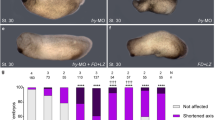Abstract
Although cell movements are vital for establishing the normal architecture of embryos, it is unclear how these movements are regulated during development in vertebrates. Inhibition of Xenopus Dishevelled (Xdsh) function disrupts convergent extension movements of cells during gastrulation, but the mechanism of this effect is unclear, as cell fates are not affected1. In Drosophila, Dishevelled controls both cell fate and cell polarity2,3,4, but whether Dishevelled is involved in controlling cell polarity in vertebrate embryos has not been investigated. Here we show, using time-lapse confocal microscopy, that the failure of cells lacking Xdsh function to undergo convergent extension results from defects in cell polarity. Furthermore, Xdsh mutations that inhibit convergent extension correspond to mutations in Drosophila Dishevelled that selectively perturb planar cell polarity. Finally, the localization of Xdsh at the membrane of normal dorsal mesodermal cells is consistent with Xdsh controlling cell polarity. Our results show that polarized cell behaviour is essential for convergent extension and is controlled by vertebrate Dishevelled. Thus, a vertebrate equivalent of the Drosophila planar cell polarity signalling cascade may be required for normal gastrulation.
This is a preview of subscription content, access via your institution
Access options
Subscribe to this journal
Receive 51 print issues and online access
$199.00 per year
only $3.90 per issue
Buy this article
- Purchase on Springer Link
- Instant access to full article PDF
Prices may be subject to local taxes which are calculated during checkout





Similar content being viewed by others
References
Sokol,S. Y. Analysis of Dishevelled signalling pathways during Xenopus development. Curr. Biol. 6, 1456–1467 (1996).
Axelrod,J. D., Miller,J. R., Shulman,J. M., Moon,R. T. & Perrimon,N. Differential recruitment of Dishevelled provides signaling specificity in the planar cell polarity and Wingless signaling pathways. Genes Dev. 12, 2610– 2622 (1998).
Boutros,M., Paricio,N., Strutt,D. I. & Mlodzik,M. Dishevelled activates JNK and discriminates between JNK pathways in planar polarity and wingless signaling. Cell 94, 109– 118 (1998).
Boutros,M. & Mlodzik,M. Dishevelled: at the crossroads of divergent intracellular signaling pathways. Mech. Dev. 83, 27–37 (1999).
Vogt,W. Gestaltungsanalyse am amphibienkeim mit örtlicher vitalfärbung. II. Teil. Gastrulation und mesodermbildung bei urodelen und anuran. Wilhelm Roux Arch. EntwMech. Org. 120, 384–706 (1929).
Keller,R., Shih,J., Wilson,P. & Sater,A. K. in 49th Symp. Soc. Develop. Biol. Cell–Cell Interactions in Early Development (ed. Gerhart, J.) 93–107 (Wiley, New York, 1991).
Keller,R., Shih,J. & Domingo,C. The patterning and functioning of protrusive activity during convergence and extension of the Xenopus organiser. Development (Suppl.) 81–91 (1992).
Shih,J. & Keller,R. Patterns of cell motility in the organizer and dorsal mesoderm of Xenopus laevis. Development 116, 915–930 ( 1992).
Shih,J. & Keller,R. Cell motility driving mediolateral intercalation in explants of Xenopus laevis. Development 116, 901–914 ( 1992).
Cadigan,K. M. & Nusse,R. Wnt signaling: a common theme in animal development. Genes Dev. 11, 3286– 3305 (1997).
Miller,J. R. et al. Establishment of the dorsal-ventral axis in Xenopus embryos coincides with the dorsal enrichment of dishevelled that is dependent on cortical rotation. J. Cell Biol. 146, 427–437 (1999).
Wallingford,J. B., Sater,A. K., Uzman,J. A. & Danilchik,M. V. Inhibition of morphogenetic movement during Xenopus gastrulation by injected sulfatase: implications for anteroposterior and dorsoventral axis formation. Dev. Biol. 187, 224–235 (1997).
Pierce,S. B. & Kimelman,D. Regulation of Spemann organizer formation by the intracellular kinase Xgsk-3. Development 121, 755–765 (1995).
Rothbächer,U. et al. Dishevelled phosphorylation, subcellular localization and homomerization regulate its role in early embryogenesis. EMBO J. 19, 1010–1022 ( 2000).
Howard,J. E. & Smith,J. C. Analysis of gastrulation: different types of gastrulation movement are induced by different mesoderm-inducing factors in Xenopus laevis. Mech. Dev. 43, 37–48 (1993).
Li,L. et al. Dishevelled proteins lead to two signaling pathways. Regulation of LEF- 1 and c-Jun N-terminal kinase in mammalian cells. J. Biol. Chem. 274, 129–134 ( 1999).
Moriyoshi,K., Richards,L. J., Akazawa,C., O'Leary,D. D. & Nakanishi,S. Labeling neural cells using adenoviral gene transfer of membrane-targeted GFP. Neuron 16, 255–260 (1996).
Acknowledgements
We thank T. Grammer, M. Dionne, A. Sater, D. Keys, K. Liu and D. Frank for discussions, reading the manuscript, and blind scoring; S. Sokol for the Xdsh and Xdd1 plasmids; and D. Turner for the memEGFP plasmid. This work was supported by the NIH, NIMH and the Beckman Institute. J.B.W. was supported by NIH/NIGMS and ACS postdoctoral fellowships; B.A.R. by a US Department of Defense Breast Cancer Research Program Grant to C. Larabell; and K.M.V. by the Nathan and Violet David Scholars program at UC Berkeley.
Author information
Authors and Affiliations
Corresponding author
Rights and permissions
About this article
Cite this article
Wallingford, J., Rowning, B., Vogeli, K. et al. Dishevelled controls cell polarity during Xenopus gastrulation . Nature 405, 81–85 (2000). https://doi.org/10.1038/35011077
Received:
Accepted:
Issue Date:
DOI: https://doi.org/10.1038/35011077
This article is cited by
-
A Yap-dependent mechanoregulatory program sustains cell migration for embryo axis assembly
Nature Communications (2023)
-
USP39 is essential for mammalian epithelial morphogenesis through upregulation of planar cell polarity components
Communications Biology (2022)
-
Mechanical regulation of early vertebrate embryogenesis
Nature Reviews Molecular Cell Biology (2022)
-
Wnt/planar cell polarity signaling controls morphogenetic movements of gastrulation and neural tube closure
Cellular and Molecular Life Sciences (2022)
-
Programmed and self-organized flow of information during morphogenesis
Nature Reviews Molecular Cell Biology (2021)
Comments
By submitting a comment you agree to abide by our Terms and Community Guidelines. If you find something abusive or that does not comply with our terms or guidelines please flag it as inappropriate.



